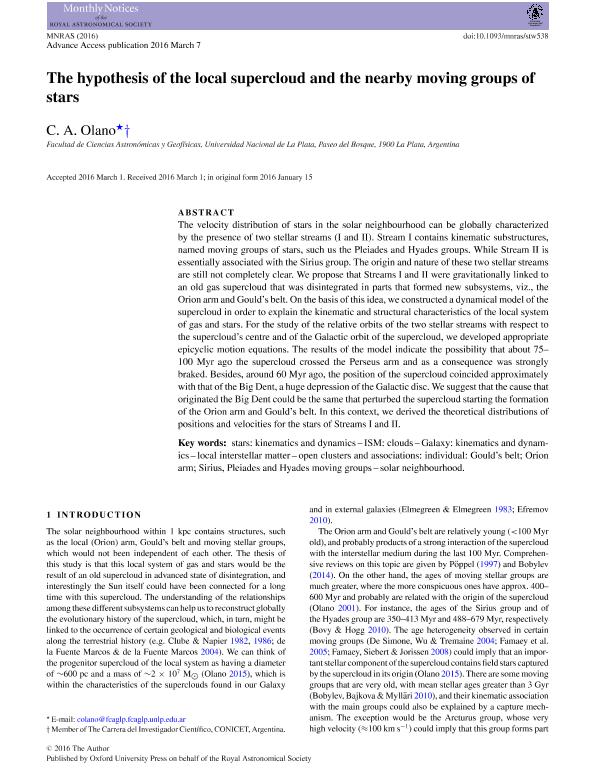Mostrar el registro sencillo del ítem
dc.contributor.author
Olano, Carlos Alberto

dc.date.available
2018-08-08T19:03:16Z
dc.date.issued
2016-03
dc.identifier.citation
Olano, Carlos Alberto; The hypothesis of the local supercloud and the nearby moving groups of stars; Oxford University Press; Monthly Notices of the Royal Astronomical Society; 458; 4; 3-2016; 4354-4367
dc.identifier.issn
0035-8711
dc.identifier.uri
http://hdl.handle.net/11336/54651
dc.description.abstract
The velocity distribution of stars in the solar neighbourhood can be globally characterized by the presence of two stellar streams (I and II). Stream I contains kinematic substructures, named moving groups of stars, such us the Pleiades and Hyades groups. While Stream II is essentially associated with the Sirius group. The origin and nature of these two stellar streams are still not completely clear. We propose that Streams I and II were gravitationally linked to an old gas supercloud that was disintegrated in parts that formed new subsystems, viz., the Orion arm and Gould's belt. On the basis of this idea, we constructed a dynamical model of the supercloud in order to explain the kinematic and structural characteristics of the local system of gas and stars. For the study of the relative orbits of the two stellar streams with respect to the supercloud's centre and of the Galactic orbit of the supercloud, we developed appropriate epicyclic motion equations. The results of the model indicate the possibility that about 75-100 Myr ago the supercloud crossed the Perseus arm and as a consequence was strongly braked. Besides, around 60 Myr ago, the position of the supercloud coincided approximately with that of the Big Dent, a huge depression of the Galactic disc. We suggest that the cause that originated the Big Dent could be the same that perturbed the supercloud starting the formation of the Orion arm and Gould's belt. In this context, we derived the theoretical distributions of positions and velocities for the stars of Streams I and II.
dc.format
application/pdf
dc.language.iso
eng
dc.publisher
Oxford University Press

dc.rights
info:eu-repo/semantics/openAccess
dc.rights.uri
https://creativecommons.org/licenses/by-nc-sa/2.5/ar/
dc.subject
Galaxy: Kinematics And Dynamics
dc.subject
Ism: Clouds
dc.subject
Local Interstellar Matter
dc.subject
Open Clusters And Associations: Individual: Gould'S Belt, Orion Arm; Sirius, Pleiades And Hyades Moving Groups
dc.subject
Solar Neighbourhood
dc.subject
Stars: Kinematics And Dynamics
dc.subject.classification
Astronomía

dc.subject.classification
Ciencias Físicas

dc.subject.classification
CIENCIAS NATURALES Y EXACTAS

dc.title
The hypothesis of the local supercloud and the nearby moving groups of stars
dc.type
info:eu-repo/semantics/article
dc.type
info:ar-repo/semantics/artículo
dc.type
info:eu-repo/semantics/publishedVersion
dc.date.updated
2018-08-08T15:00:39Z
dc.journal.volume
458
dc.journal.number
4
dc.journal.pagination
4354-4367
dc.journal.pais
Reino Unido

dc.journal.ciudad
Oxford
dc.description.fil
Fil: Olano, Carlos Alberto. Universidad Nacional de La Plata. Facultad de Ciencias Astronómicas y Geofísicas; Argentina. Consejo Nacional de Investigaciones Científicas y Técnicas; Argentina
dc.journal.title
Monthly Notices of the Royal Astronomical Society

dc.relation.alternativeid
info:eu-repo/semantics/altIdentifier/doi/http://dx.doi.org/10.1093/mnras/stw538
dc.relation.alternativeid
info:eu-repo/semantics/altIdentifier/url/https://academic.oup.com/mnras/article-abstract/458/4/4354/2613826
Archivos asociados
